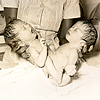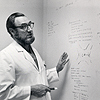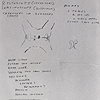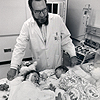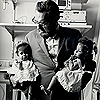
Separation Surgeries (20th century)
Brief overview of attempts and successes
Historically, the separation of conjoined twins was frowned upon. Even if the physicians thought it might be anatomically possible, the twins' relations, who often had a vested financial interest in keeping the twins together, usually dismissed the idea. In fact surgical separation was only seriously considered if one of the twins acquired an incurable disease. For example, both Eng and Millie were advised to seriously consider separation when Chang and Christine became gravely ill with pneumonia and tuberculosis, respectively; both refused.
Early surgeries were usually only performed on xiphopagus twins, which were joined by only a band of skin and tissue. The earliest recorded successful case occurred in 1690, when two sisters were separated by means of having a ligature around the band tightened daily until at last the final bit of skin was separated by a knife.
Surgeries on other types of twins, with more shared tissues or organs, frequently resulted in the survival of only one twin. Such was the case of Maria-Rosalina, thoracopagus twins who were separated in May 1900 by Eduoard Chapot-Prévost. Maria died eight days after separation, but Rosalina survived.
By the 1950s advancing medical knowledge and technology enabled both conjoined twins of many different types to survive separation. Dr. Maitland Baldwin performed one of the first successful operations to separate craniopagus twins, on Dec. 11, 1956, at the National Institutes of Health. On Oct. 5, 1957, at The Children's Hospital of Philadelphia, Dr. C. Everett Koop performed one of the first successful operations to separate pygopagus twins. Nearly twenty years later Koop also lead a team at Children's Hospital that successfully separated ischiopagus twins, Clara and Alta Rodriguez, who are profiled below.
Clara-Alta Rodriguez
Clara and Altagracia (Alta) Rodriguez were born in San José de Ochoa, Dominican Republic, on August 12, 1973. They were ischiopagus twins, joined together at the lower trunk and pelvis. Their gastrointestinal urinary and reproductive systems were partially united. Clara was the dominant twin of the two; Alta was clearly much weaker.
Thanks to the efforts of relatives and church groups in the United States, the one year old twins were brought to The Children's Hospital of Philadelphia to be separated in September 1974. Chief of Pediatric Surgery Dr. C. Everett Koop, who had successfully performed a similar surgery 18 years earlier, said that if they remained conjoined the girls would never be able to sit up at the same time.
Koop led a team of 26 doctors and nurses in the eight hour separation surgery. Post-operatively, the girls remained in the intensive care unit for eighty-two days. Additional surgery was also required to shape the girls' pelvic bones so that they would be able to walk.
The twins returned home in 1975, where Dominican President Joaquin Balaguer awarded Dr. Koop with a medal for the surgery. Mrs. Rodriguez was honored with a presidential decree which allowed her to travel to Puerto Rico to obtain baby supplies and medicine not available in her own country and to bring them back duty-free. Sadly, one year after the separation of the two sisters Alta choked on a bean. Clara survived to maturity and gave birth to a healthy baby boy in 1994.
Note: All images displayed on this page may be found in the C. Everett Koop Papers at the National Library of Medicine and are the courtesy of Dr. Koop. Images of the separated twins taken at the hospital are posted to the website by permission of The Children's Hospital of Philadelphia. Every effort was made to secure the permissions to post the other images, but the current copyright owner either could not be identified or could not be contacted. If you have information regarding the copyright owner, please contact us at NLM Customer Support.
Last Reviewed: March 11, 2024


